Sampling Methods for Luminescence Dating of Subsurface Deposits from Cores
Abstract
:1. Introduction
2. Drilling and Augering Methods
2.1. Augers
Auger Sampling Methods for Sand Dunes
2.2. Vibracorers
2.3. Piston and Gravity Corers
2.4. Percussion Drivers
2.5. Rotary-Vibratory (Sonic) Drill
2.6. Rotary Drill
3. Core Sampling Methods for Luminescence Dating
3.1. Whole (Unsplit) Cores
3.2. Opened Cores and Cuttings Exposed to Light
- Remove and discard 1–2 cm of clay smear from the outer diameter of the core.
- Cut core in half to preserve one side for non-OSL analyses.
- Collect sediment from the split face (inner material) of core for DE processing, as seen in Figure 4B. In this case, the split core face material was safe to collect for the DE sample as it was opened (split) in the dark room.
- Collect remaining sediment for water content and DR samples.
3.3. In-the-Dark Field Sampling and Portable Luminescence Measurements on Core
4. Uncertainties and Mitigations
5. Summary
Author Contributions
Funding
Acknowledgments
Conflicts of Interest
References
- Aitken, M.J. An Introduction to Optical Dating: The Dating of Quaternary Sediments by the Use of Photon-Stimulated Luminescence; Oxford University Press: New York, NY, USA, 1998; pp. 1–267. [Google Scholar]
- Nelson, M.S.; Gray, H.J.; Johnson, J.A.; Rittenour, T.M.; Feathers, J.K.; Mahan, S.A. User Guide for Luminescence Sampling in Archaeological and Geological Contexts. Adv. Archaeol. Pract. 2015, 3, 166–177. [Google Scholar] [CrossRef]
- Munyikwa, K.; Telfer, M.; Baker, I.; Knight, C. Core drilling of Quaternary sediments for luminescence dating using the Dormer DrillmiteTM. Anc. TL 2011, 29, 15–24. [Google Scholar]
- Armitage, S.J.; Pinder, R.C. Testing the applicability of optically stimulated luminescence dating to Ocean Drilling Program cores. Quat. Geochronol. 2017, 39, 124–130. [Google Scholar] [CrossRef]
- Huntley, D.J.; Godfrey-Smith, D.I.; Thewalt, M.L.W. Optical dating of sediments. Nature 1985, 313, 105–107. [Google Scholar] [CrossRef]
- Rhodes, E.J. Optically Stimulated Luminescence Dating of Sediments Over the Past 200,000 Years. Annu. Rev. Earth Plan. Sci. 2011, 39, 461–488. [Google Scholar] [CrossRef]
- Ankjӕrgaard, C.; Guralnik, B.; Buylaert, J.-P.; Reimann, T.; Yi, S.W.; Wallinga, J. Violet stimulated luminescence dating of quartz from Luochuan (Chinese loess plateau): Agreement with independent chronology up to ~600 ka. Quat. Geochronol. 2016, 34, 33–46. [Google Scholar] [CrossRef]
- Jain, M.; Murray, A.S.; Bøtter-Jensen, L. Optically stimulated luminescence dating: How significant is incomplete light exposure in fluvial environments? Quaternaire 2004, 15, 143–157. [Google Scholar] [CrossRef]
- Berger, G.W. Trans-arctic-ocean tests of fine-silt luminescence sediment dating provide a basis for an additional geochronometer for this region. Quat. Sci. Rev. 2006, 25, 2529–2551. [Google Scholar] [CrossRef]
- Guibert, P.; Lahaye, C.; Bechtel, F. The importance of U-series disequilibrium of sediments in luminescence dating: A case study at the Roc de Marsal Cave (Dordogne, France). Radiat. Meas. 2009, 44, 223–231. [Google Scholar] [CrossRef]
- Kadereit, A.; DeWitt, R.; Johnson, T.C. Luminescence properties and optically (post-IR blue-light) stimulated luminescence dating of limnic sediments from northern Lake Malawi- Chances and limitations. Quat. Geochronol. 2012, 10, 160–166. [Google Scholar] [CrossRef]
- Frew, C. Coring Methods. In Geomorphological Techniques (Online Edition); Cook, S.J., Clarke, L.E., Nield, J.M., Eds.; British Society for Geomorphology: London, UK, 2014; Chapter 4; Section 1.1; pp. 1–10. [Google Scholar]
- Skilbeck, C.G.; Trevathan-Tackett, S.; Apichanangkool, P.; Macreadie, P.I. Chapter 5 Sediment Sampling in Estuaries: Site Selection and Sampling Techniques. In Developments in Paleoenvironmental Research: Applications of Paleoenvironmental Techniques in Estuarine Studies (eBook); Weckström, K., Saunders, K.M., Gell, P.A., Skilbeck, C.G., Eds.; Springer: Dordrecht, The Netherlands, 2017; pp. 89–120. [Google Scholar]
- Bristow, C.S.; Lancaster, N.; Duller, G.A.T. Combining ground penetrating radar surveys and optical dating to determine dune migration in Namibia. J. Geol. Soc. Lond. 2005, 162, 315–321. [Google Scholar] [CrossRef]
- Bristow, C.S.; Duller, G.A.T.; Lancaster, N. Age and dynamics of linear dunes in the Namib Desert. Geology 2007, 35, 555–558. [Google Scholar] [CrossRef]
- DeJong, B.D.; Bierman, P.R.; Newell, W.L.; Rittenour, T.M.; Mahan, S.A.; Balco, G.; Rood, D.H. Pleistocene relative sea levels in the Chesapeake Bay region and their implications for the next century. GSA Today 2015, 25, 4–10. [Google Scholar] [CrossRef]
- Wallinga, J.; van der Staay, J. Sampling in waterlogged sands with a simple hand operated corer. Anc. TL 1999, 17, 59–61. [Google Scholar]
- Lanesky, D.E.; Logan, B.W.; Brown, R.G.; Hine, A.C. A new approach to portable vibracoring underwater and on land. J. Sediment. Res. 1979, 49, 654–657. [Google Scholar] [CrossRef]
- Chambers, J.W.; Cameron, N.G. A rod-less piston corer for lake sediments: An improved, rope-operated percussion corer. J. Paleolimnol. 2001, 25, 117–122. [Google Scholar] [CrossRef]
- U.S. Army Corps of Engineers. State-of-the-Art of Marine Soil Mechanics and Foundation Engineering; U.S. Army Corps Engineers: Washington, DC, USA, 1972. [Google Scholar]
- Myrbo, A.; Wright, H.E. An introduction to Livingstone and Bolivia coring equipment. Limnol. Res. Cent. Core Facil. SOP Ser. 2008, Draft v.3.1, 12p. Available online: http://lrc.geo.umn.edu/laccore/assets/pdf/sops/livingstone-bolivia.pdf (accessed on 15 August 2019).
- Nelson, M.S.; Eppes, M.C.; Rittenour, T.M. Luminescence signals from soil and saprolite in deeply weathered profiles—Intriguing new results from the piedmont of North Carolina (Invited Presentation). In Proceedings of the GSA Annual Meeting, Phoenix, AZ, USA, 22–25 September 2019. [Google Scholar] [CrossRef]
- Geoprobe. Available online: https://geoprobe.com (accessed on 10 July 2019).
- PeaceCorps. Well Construction: Hand Dug and Hand Drilled. Information Collection and Exchange 1982, Manual M-9. Available online: http://ces.iisc.ernet.in/energy/water/paper/drinkingwater/wellsconstruction/ (accessed on 15 August 2019).
- State of Hawai’i. Section 5, Field Collection of Soil and Sediment Samples. In TGM for the Implementation of the Hawai’i State Contingency Plan; State of Hawai’i: Honolulu, HI, USA, 2016. Available online: http://www.hawaiidoh.org/TGM.aspx?p=0500a.aspx (accessed on 15 August 2019).
- Hardy, F.; Lamothe, M. Quaternary basin analysis using infrared stimulated luminescence on borehole cores and cuttings. Quat. Sci. Rev. 1997, 16, 417–426. [Google Scholar] [CrossRef]
- Preusser, F.; Radies, D.; Matter, A. A 160,000-Year record of dune development and atmospheric circulation in southern Arabia. Science 2002, 296, 2018–2020. [Google Scholar] [CrossRef]
- Biswas, R.H.; Herman, F.; King, G.E.; Braun, J. Thermoluminescence of feldspar as a multi-thermochronometer to constrain the temporal variation of rock exhumation in the recent past. Earth Planet. Sci. Lett. 2018, 495, 56–68. [Google Scholar] [CrossRef]
- King, G.E.; Guralnik, B.; Valla, P.G.; Herman, F. Trapped-charge thermochronometry and thermometry: A status review. Chem. Geol. 2016, 446, 3–17. [Google Scholar] [CrossRef]
- Roberts, H.M.; Bryant, C.I.; Huws, D.G.; Lamb, H.F. Generating long chronologies for lacustrine sediments using luminescence dating: A 250,000year record from Lake Tana, Ethiopia. Quat. Sci. Rev. 2018, 202, 66–77. [Google Scholar] [CrossRef]
- Lowick, S.E.; Preusser, F. A method for retrospectively calculating the water content for silt-dominated desiccated core samples. Anc. TL 2009, 27, 9–14. [Google Scholar]
- Duller, G.A.T.; Li, S.H.; Musson, F.M.; Wintle, A.G. Use of infrared stimulated luminescence signal for scanning sediment cores. Quat. Sci. Rev. 1992, 11, 115–119. [Google Scholar] [CrossRef]
- Sanderson, D.C.W.; Murphy, S. Using simple portable OSL measurements and laboratory characterization to help understand complex and heterogeneous sediment sequences for luminescence dating. Quat. Geochronol. 2010, 5, 299–305. [Google Scholar] [CrossRef]
- Smedley, R.K.; Buylaert, J.-P.; Újvári, G. Comparing the accuracy and precision of luminescence ages for partially-bleached sediments using single grains of K-feldspar and quartz. Quat. Geochronol. 2019, 53, 11. [Google Scholar] [CrossRef]
- Duller, G.A.T.; Bøtter-Jensen, L.; Murray, A.S.; Truscott, A.J. Single grain laser luminescence (SGLL) measurements using a novel automated reader. Nucl. Instrum. Methods Phys. Res. B 1999, 155, 506–514. [Google Scholar] [CrossRef]
- Galbraith, R.F.; Roberts, R.G. Statistical aspects of equivalent dose and error calculation and display in OSL dating: An Overview and some recommendations. Quat. Geochronol. 2012, 11, 1–27. [Google Scholar] [CrossRef]
- Bateman, M.D.; Frederick, C.D.; Jaiswal, M.K.; Singhvi, A.K. Investigations into the potential effects of pedoturbation on luminescence dating. Quat. Sci. Rev. 2003, 22, 1169–1176. [Google Scholar] [CrossRef]
- Gliganic, L.A.; May, J.-H.; Cohen, T.J. All mixed up: Using single-grain equivalent dose distributions to identify phases of pedogenic mixing on a dryland alluvial fan. Quat. Int. 2015, 362, 23–33. [Google Scholar] [CrossRef]
- Nelson, M.S.; Rittenour, T.M. Using grain-size characteristics to model soil water content: Application to dose-rate calculation for luminescence dating. Radiat. Meas. 2015, 82, 142–149. [Google Scholar] [CrossRef]
- Polymeris, G.S.; Kitis, G.; Liolios, A.K.; Sakalis, A.; Zioutas, K.; Anassontzis, E.G.; Tsirliganis, N.C. Luminescence dating of the top of a deep water core from the NESTOR site near the Hellenic Trench, east Mediterranean Sea. Quat. Geochronol. 2009, 4, 68–81. [Google Scholar] [CrossRef]
- Wintle, A.G.; Huntley, D.J. Thermoluminescence dating of a deep-sea sediment core. Nature 1979, 279, 710–712. [Google Scholar] [CrossRef]
- Wintle, A. A thermoluminescence dating study of some Quaternary calcite: Potential and problems. Can. J. Earth Sci. 1978, 15, 1977–1986. [Google Scholar] [CrossRef]
- Rodrigues, A.L.; Dias, M.I.; Valera, A.C.; Rocha, F.; Prudêncio, M.I.; Marques, R.; Cardoso, G.; Russo, D. Geochemistry, luminescence and innovative dose rate determination of a Chalcolithic calcite-rich negative feature. J. Arch. Sci. Rep. 2019, 26, 1–13. [Google Scholar] [CrossRef]
- Fulop, E.C.; Johnson, B.G.; Keen-Zebert, A. A geochronology-supported soil chronosequence for establishing the timing of shoreline parabolic dune stabilization. CATENA 2019, 178, 232–243. [Google Scholar] [CrossRef]
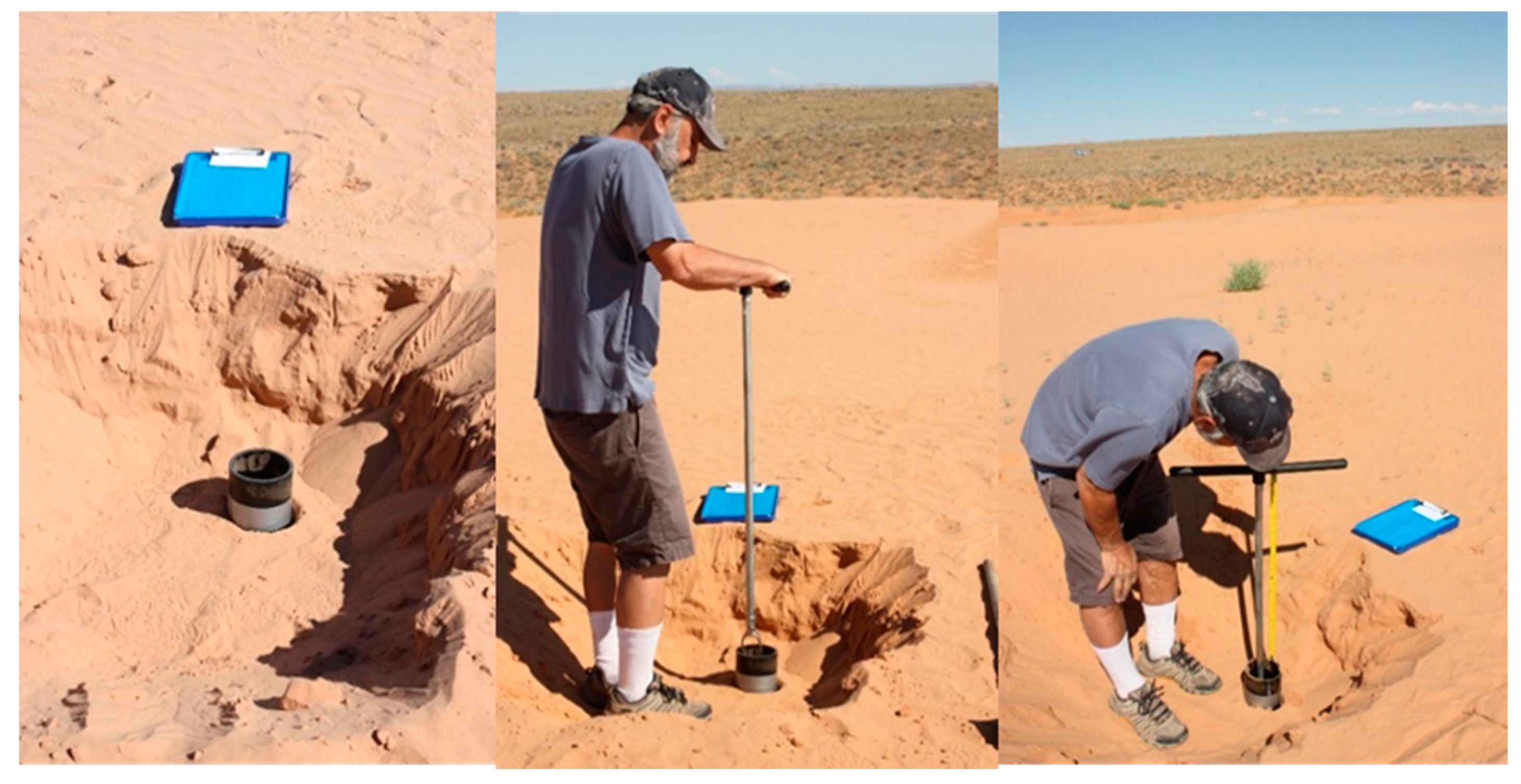
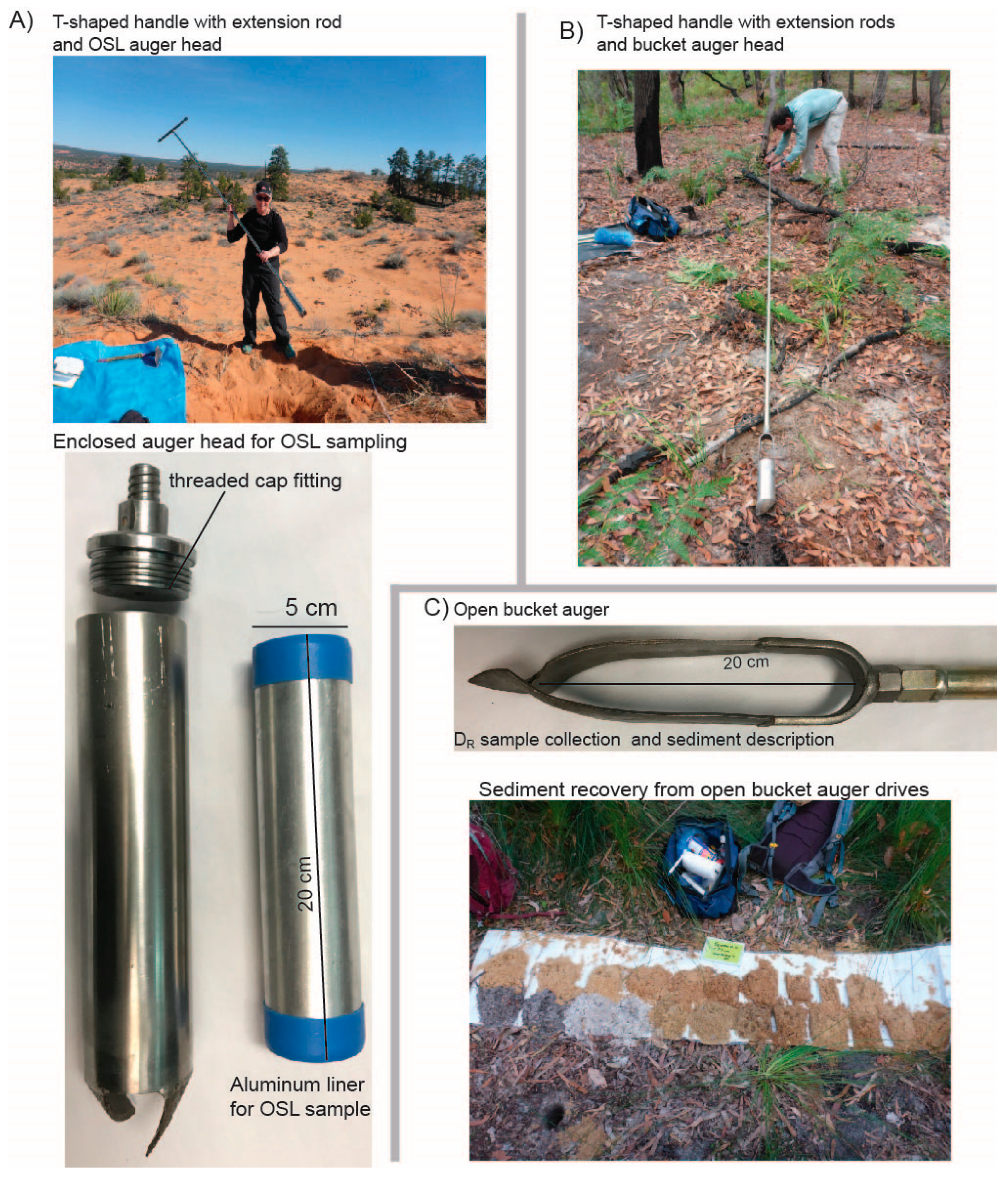
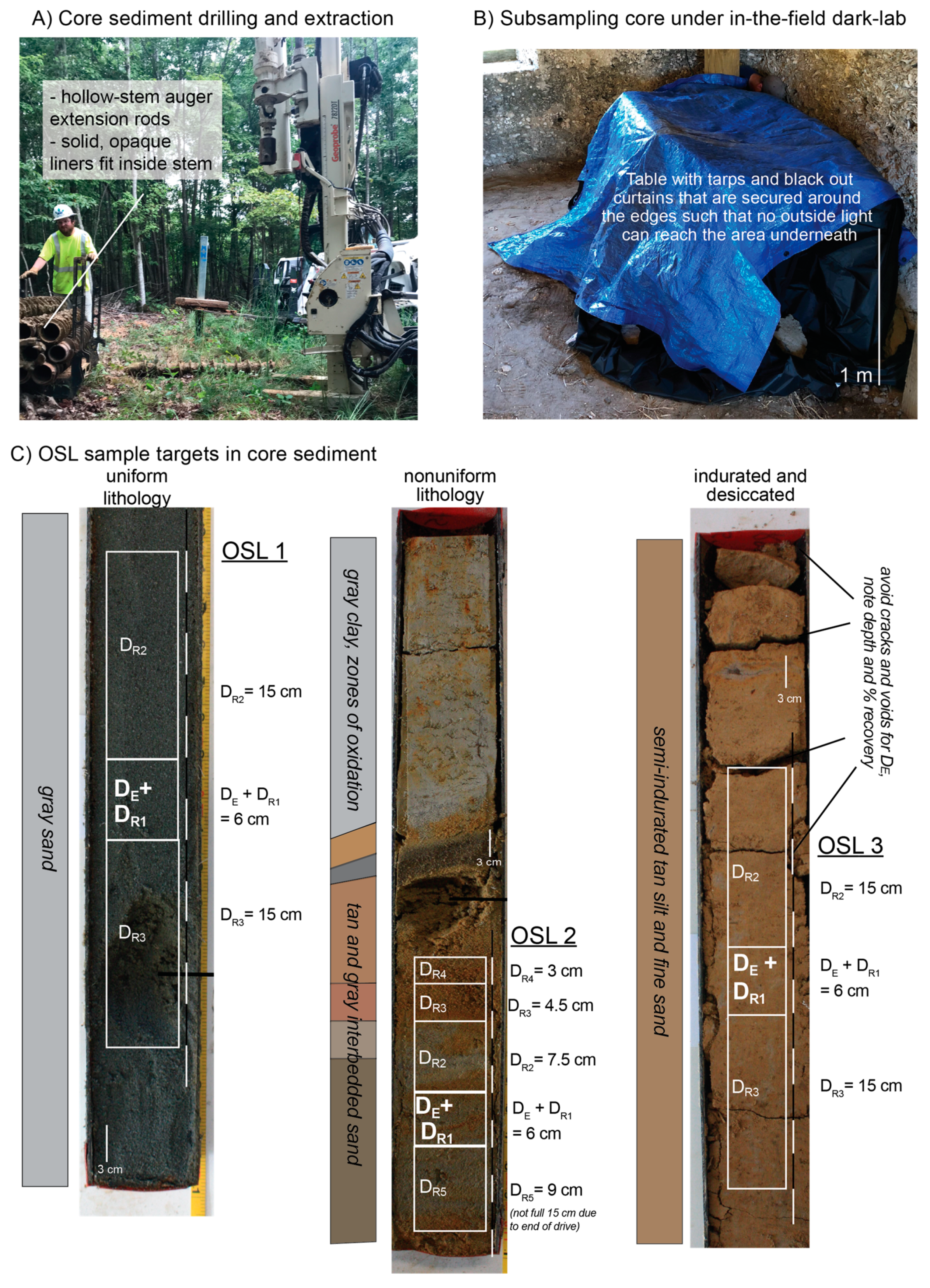
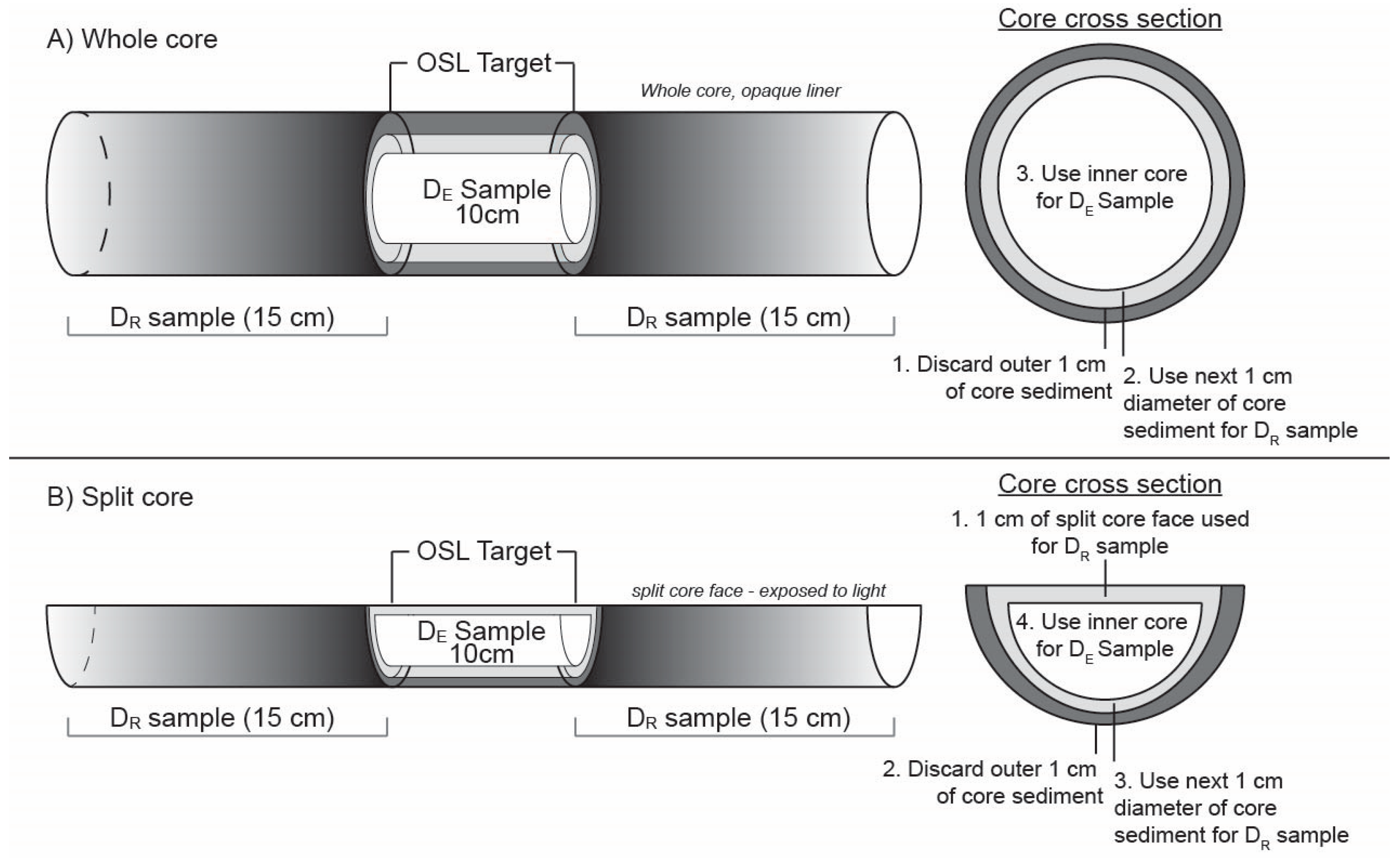
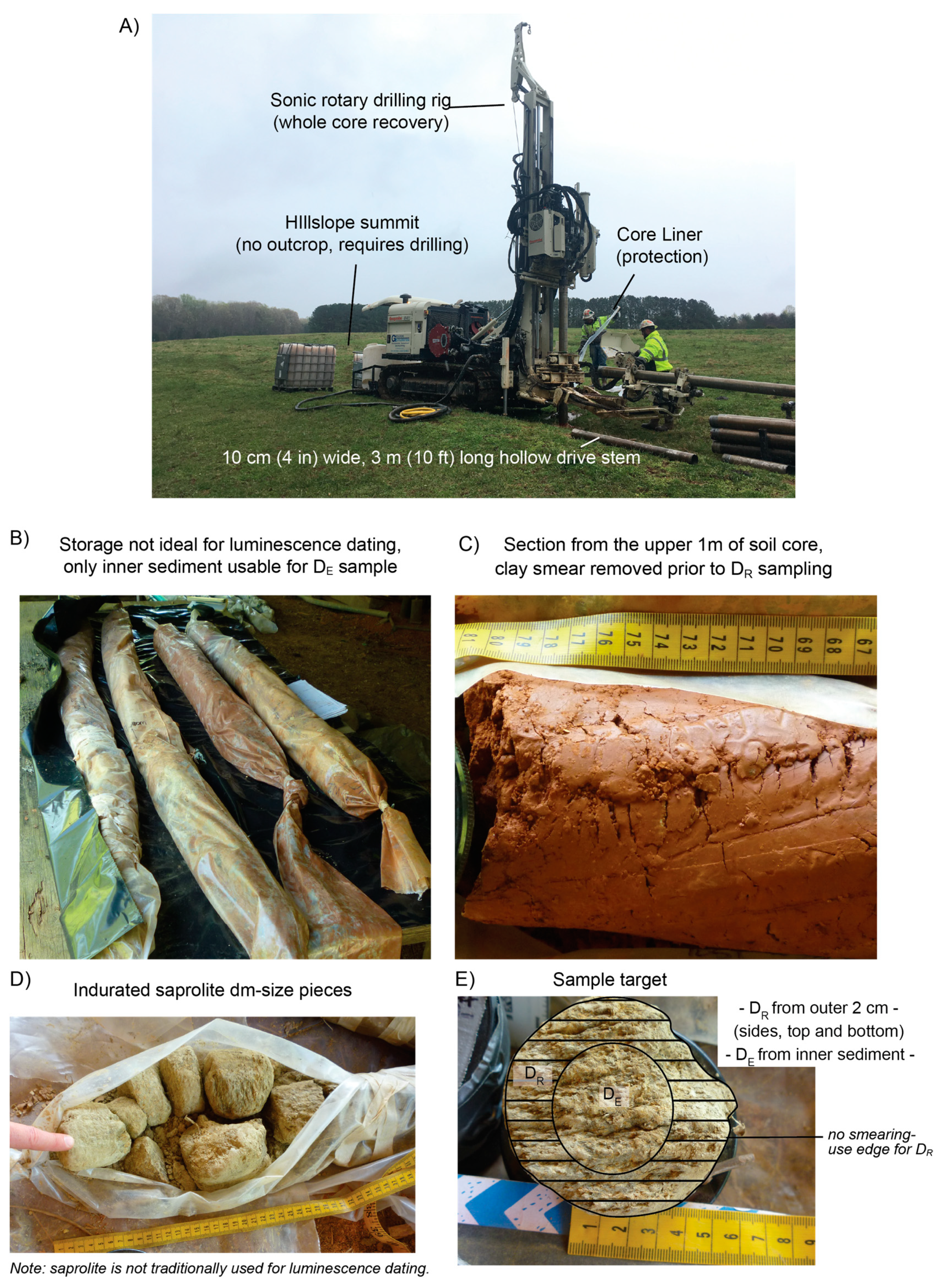
© 2019 by the authors. Licensee MDPI, Basel, Switzerland. This article is an open access article distributed under the terms and conditions of the Creative Commons Attribution (CC BY) license (http://creativecommons.org/licenses/by/4.0/).
Share and Cite
Nelson, M.; Rittenour, T.; Cornachione, H. Sampling Methods for Luminescence Dating of Subsurface Deposits from Cores. Methods Protoc. 2019, 2, 88. https://doi.org/10.3390/mps2040088
Nelson M, Rittenour T, Cornachione H. Sampling Methods for Luminescence Dating of Subsurface Deposits from Cores. Methods and Protocols. 2019; 2(4):88. https://doi.org/10.3390/mps2040088
Chicago/Turabian StyleNelson, Michelle, Tammy Rittenour, and Harriet Cornachione. 2019. "Sampling Methods for Luminescence Dating of Subsurface Deposits from Cores" Methods and Protocols 2, no. 4: 88. https://doi.org/10.3390/mps2040088
APA StyleNelson, M., Rittenour, T., & Cornachione, H. (2019). Sampling Methods for Luminescence Dating of Subsurface Deposits from Cores. Methods and Protocols, 2(4), 88. https://doi.org/10.3390/mps2040088



